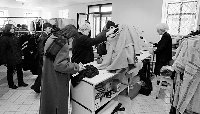The Swallow Returns

As factory director Ella Churenova told me about this, I remembered how compactly, one might even say crammed together, the dresses, trousers, suits, jackets, raincoats, and overcoats used to hang there. There were quite fashionable items and even some that would decorate any boutique specializing in imported clothes. However, two distinctive features linked those articles bearing the Lastivka trademark: a low price and somewhat crumpled look due to insufficient space on the shelves. In a word, the shop resembled our Soviet-era department stores. With the only difference that it had far more goods and far fewer customers.
The director takes a handwritten notebook featuring the lines the factory produces. She turns a page and splits a blank sheet into several parts. "These are the elite 10%. They either get their clothes sewn by stylish tailors, or buy at expensive stores. Below them are 70%, our customers or the mass client. And the bottom 20% are those who don't buy clothes at all. In principle, all nations have about the same ratio. But in the West, 10% of our group moved up, while in Ukraine around 20% came down to the bottom group. Still, it's wonderful to have a market embracing over half the population. What opportunities it offers!"
In the meantime, I take a close look of the director's office and see old furniture, worn varnish on the floor, and none of the televisions or computers which have become de rigueur in other managers' offices. It's a poor life Lastivka lives.
"But," I ask Ms. Churenova, "I hear that you export a great deal of your products, don't you?"
"The enterprise has had to switch to reprocessing arrangements with foreign companies because there was no better alternative, and it has not made any money from it," the director continues. "In essence, all we sell is our seamstresses' labor. High-quality labor, as they recognize in the West, but very low-cost. And this being the case, they have closed down their clothing factories in the West. They export to Eastern European and former Soviet Union countries material, accessories, technologies, models, and import finished products which are then sold not at all cheap. Compared to business activity on the local market, this is less profitable, but it allows the enterprise to keep jobs. Otherwise, of 1000 workers currently employed in the factory, about 750 would now be unemployed."
"It seems that the other day the government remembered about light industry..."
"These measures are very late in coming. The sector has been virtually destroyed. And now I am afraid the remnants in will get such dubious benefits like obstacles to imports. In fact, a substantial share of our clothes returns here and is sold both by private traders like shuttle goods and in posh shops. I go to market every Sunday, where I ask vendors about variety, quality, and the origin of their wares. Believe me, we are inferior in nothing to our competitors, and there are many respects in which we outdo them. And our prices, as you see, are quite competitive. What we need is low-interest long-term loans to replenish working capital, and some alleviation of the tax burden. And, of course, we depend on people's buying power. There is no way we give up to the competition."
My next question concerns earnings at the factory. Commercial secrets guarded, I am told that wages here are above the average in the sector. For instance, Lastivka displayed its samples at a recent Leipzig Fair. Their partners liked the samples, but when price was discussed, they said that other Ukrainian dealers offer lower prices. (In the provinces, explains Mr. Churenova, wages are lower than in Kyiv, but with other balancing factors (the capital does not lose out).
Although the factory has lately had no arrears in wages, compulsory unpaid vacations have become the norm. In one factory's shop I saw an application for such vacations, which the whole team had been forced to sign. But the workers said that the material, whose absence had nearly caused the standstill, had already arrived and now they are back at work.
19-year-old seamstress Ania, no work at the moment, was reading a magazine. Her monthly pay is Hr 120 ($30), not exactly a fortune. But, as Ella Churenova explained, sometimes the workers earn that amount for only one or two working weeks.
Another current paradox is wages paid in advance. Lastivka employees can buy any of their products on credit. Some workers wear them, others sell them, increasing their earnings somewhat. I got the impression that the practice is even encouraged at the factory, and any employee can make additional money selling goods. However, all this is within legal limits. The enterprise, accommodated in the center of the capital, operates in "broad daylight".
Preserving the widest variety of clothes ranging from blouses to overcoats, Lastivka has switched to small (100-200 item) consignments. It is not that simple, but otherwise the goods would not sell. And the most important: the factory gradually returns to the Ukrainian market, using no-interest credits granted by foreign partners against goods.
In the meantime, the ambition to have a market embracing half the population
is in practice just a pipe dream. Only 10% of Lastivka goods designed for
local customers are sold in Ukrainian regions, and the rest at the factory
shop. In a word, Lastivka, one of the biggest Ukrainian clothing enterprises
currently operating, is trying to come home.
Newspaper output №:
№12, (1999)Section
Economy





